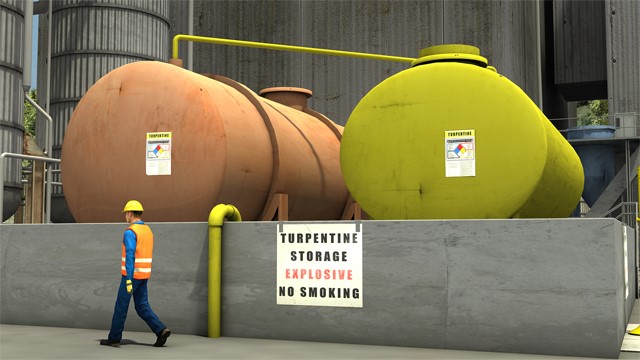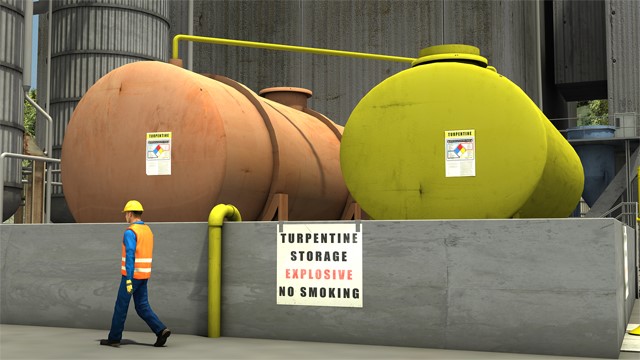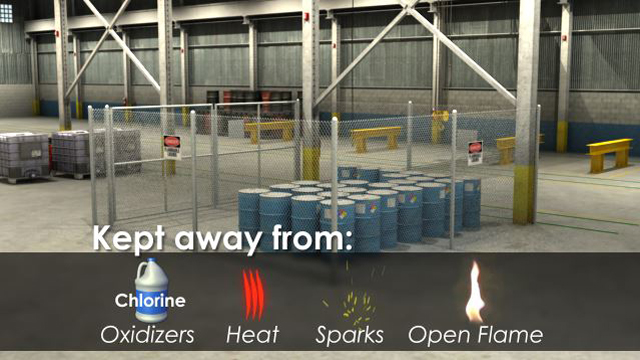




Turpentine Awareness
Turpentine, also called the spirit of turpentine, oil of turpentine, or wood turpentine, is a fluid obtained by distilling resin from pine trees and other coniferous trees. It is a colorless, volatile liquid with a strong odor. Turpentine is often used as a solvent or thinner for oil-based paints and varnishes. Working with or around turpentine is sometimes unavoidable, so it is critical that you use the proper PPE, follow standard procedures, and know how to handle leaks, spills, and other emergency situations. This course describes what turpentine is, its uses, the hazards it presents, and how to protect yourself from those hazards.
Request a demoCourse Details
Learning Objectives
• Description of turpentine and its sources • Current and former uses for turpentine • PPE and handling requirements • Exposure and toxicity information • Potential health hazards and effects • Emergency response procedures
Specs
| Course Level | Intermediate |
| Languages | English |
| Compatibility | Audio, Video |
| Based on: | Industry Standards and Best Practices |
Key Questions
How is Turpentine obtained, and what are some common characteristics of it?
Turpentine is a fluid obtained by distilling resin from pine trees and other coniferous trees. It is a colorless, volatile liquid with a strong odor. Turpentine is often used as a solvent or thinner for oil-based paints and varnishes.
In what ways can Turpentine be produced?
Turpentine can be produced in several different ways. Gum turpentine is produced by distilling resin obtained from living trees. Wood, or sulfate, turpentine is mostly obtained as a by-product of the kraft chemical pulping process, though wood turpentine can also be obtained from old pine stumps and branches. “Mineral turpentine” is one of several petroleum distillates that are sometimes used as solvents in place of turpentine, though they are very different chemically.
How has the National Fire Protection Association (NFPA) rated Turpentine?
The National Fire Protection Association (NFPA) flammability rating for turpentine is 3, which means it is extremely flammable and a serious fire hazard. Heat, exposure to air in a confined space, and sources of ignition may all cause instability or spontaneous ignition. Additionally, contact of turpentine with oxidation catalysts or with strong oxidizing agents, especially chlorine, may cause fires and explosions.
What negative health effects can be caused by inhaling or ingesting Turpentine?
Inhalation or ingestion of turpentine can cause: irritation of skin, eyes, and upper respiratory system, burning sensation in mouth and throat, headache or ringing in ears (tinnitus), chest pain, shortness of breath, and difficulty breathing, nausea, vomiting, and digestive disorders, urinary tract, kidney, or bladder problems, symptoms of drunkenness, brain damage, seizures and convulsions, and lastly coma or death.
How should you show precaution and handle Turpentine when storing it?
The containers should be stored in such a way that they are protected from physical damage and kept away from strong oxidizers (especially chlorine), heat, sparks, and open flames. Only non-sparking tools may be used near or to handle turpentine.
Sample Video Transcript
Turpentine is a volatile mixture of hydrocarbons that can be acquired from several different coniferous trees. In the United States, the primary sources of commercial turpentine are the longleaf and slash pine species that are native to the Southeast. Turpentine can be produced in several different ways. Gum turpentine is produced by distilling resin obtained from living trees. Wood or sulfate turpentine is mostly obtained as a byproduct of the kraft chemical pulping process. Though wood turpentine can also be obtained from old pine stumps and branches. In the kraft pulping process, wood chips are cooked with chemicals at high temperatures and high pressures in large pressure vessels called digesters. The vapors that are removed from the digesters during cooking are condensed and then distilled to obtain wood turpentine. Mineral turpentine is one of several petroleum distillates that are sometimes used as solvents in place of turpentine, though they are very different chemically.
Additional Resources
- U.S. Department of Labor’s Occupational Safety & Health Administration (OSHA) – www.osha.gov
- OSHA Data Sheets – https://www.osha.gov/dts/chemicalsampling/data/CH_274700.html
- National Institute for Occupational Safety and Health (NIOSH) – www.cdc.gov/niosh/
- NIOSH Publications and Products – http://www.cdc.gov/niosh/idlh/8006642.HTML
- NIOSH Pocket Guide – http://www.cdc.gov/niosh/npg/npgd0648.html
Demos + Pricing
Learn more about our courses, get pricing, and see our platform.











